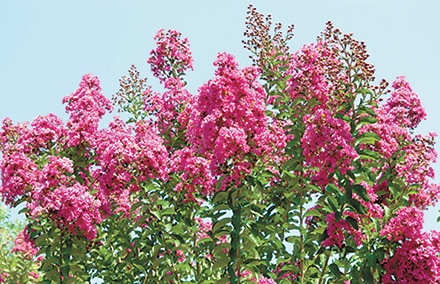They tolerate the hot dry conditions of summer and are seldom troubled by pests. The plants are frequently planted along highways and interstates adding color to the roadside landscape.
Crape myrtles vary in size from smaller than three feet to those that reach 20 or more feet in height. Their flowers range from white to lavender to pink as well as many other colors. The time they bloom during the summer varies with the cultivar. Some continuously bloom throughout the summer while others bloom only for a specific period of time. In the fall the leaves turn bright red to yellow before they drop. Some have attractive bark that is exfoliating, meaning it peals away exposing the trunk which has a gray to brown color.
Although they can tolerate adverse growing conditions, they perform better if they are planted in well prepared soil. As when planting other ornamentals trees and shrubs, dig the hole twice the width of the root ball and no deeper than the top of the root ball. Fill in the hole with the soil that was dug out removing rocks and other debris. Research has shown that organic matter amendments are not necessary when planting individual holes. Water the plants thoroughly once a week until the plants become established. Do not apply fertilizers high in nitrogen. They encourage excessive vegetative growth and reduce flower production in addition to making the plants more susceptible to insects, and diseases. Light applications of fertilizers in spring and summer are all that is needed.
The most common pest on crape myrtles is the fungus, powdery mildew. It appears as a white to grayish powder on the surfaces of leaves, flowers and new shoots. Plants that are growing in shady, damp locations with poor air circulation are the most susceptible. The disease prefers dry, warm days and cool night temperatures with high humidity. To control the fungus, locate plants in full sun and plant resistant varieties like ‘Natchez’, ‘Muskogee,’ ‘Sioux,’ and ‘Tuskegee.’ Chemical control of powdery mildew is difficult to achieve. Sometimes tiny insects called aphids infest crape myrtles and secrete a sugary substance that promotes the growth of black sooty mold. The aphids can be controlled by applications of insecticidal soaps or summer horticultural oils.
Crape myrtle flowers on new growth each season, so you can prune plants any time during the late winter or early spring before growth begins without loss of flower buds.
Pruning the crape myrtles promotes the development of new shoots and flowers. However, very little pruning is actually necessary, and frequently people prune them far too aggressively.
Crape myrtles provide attractive flowers and thrive in our summers. Very few flowering trees and shrubs produce flowers like these do. Crape myrtles are a great asset to the landscape. They are easy to grow and provide excellent color during the summer. No landscape would be complete without them.
Timothy Daly is an Agricultural and Natural Resource Agent with Gwinnett County Extension. He can be contacted at 678-377-4010 or timothy.daly@gwinnettcounty.com


